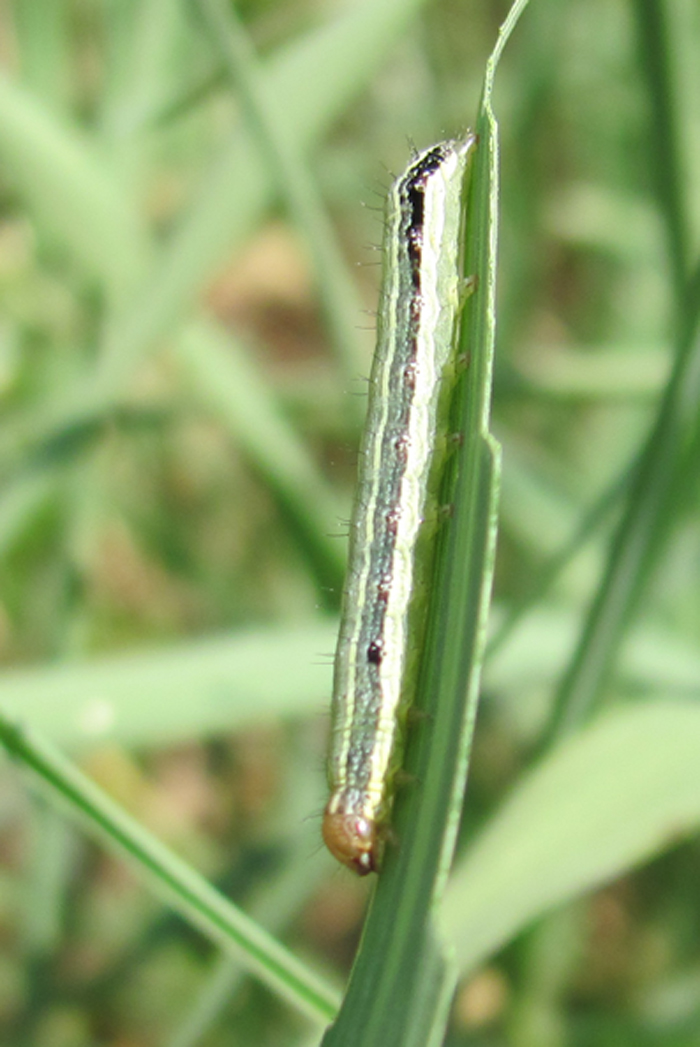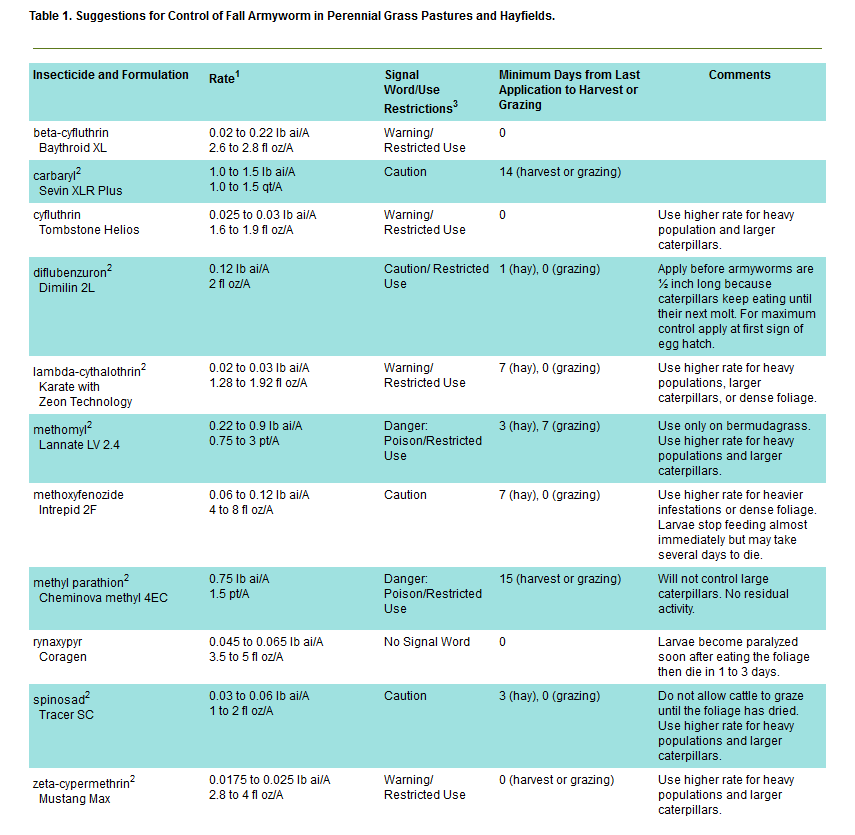
Large armyworms were seen defoliating a Tifton 85 Bermudagrass field recently in Holmes County. Photo credit: Liza Garcia-Jimenez
Every summer, fall armyworm moths fly up from South Florida to lay their eggs in well fertilized hay fields and forage crops in the the tri-state region. The timing of the first major infestations varies from year to year, from May through August. Judging by reports that have come in to the Extension Office this year, it appears that July is the month for 2014. If you have not scouted your fertilized Bermudagrass fields lately, it would be a good idea to make that a regular routine for the remainder of the season.
Armyworm Life Cycle
It is important to understand the life cycle of armyworms. Armyworms are in the larvae stage, actively feeding on forages for only 2-3 weeks of their life cycle, so you may have a population living in your field, but not see the worms. They spend 10-14 days pupating underground, 2-3 weeks as worms, and then 2-3 weeks as adult moths mating and laying eggs. In essence, armyworms come in waves about 4-5 weeks apart. There are exceptions, when populations are so large that multiple generations are hatching out at different times, but generally the worms eating a hay field are of similar age and length.
Scouting for Armyworms
Seeing a flock of cowbirds feeding on a field, can be an indicator of an armyworm infestation, but these birds may not be attracted to a field until the worms are already large in size, and have done considerable damage to the field. Hay producers would be advised to scout well fertilized fields at least weekly from June through September for worms. The worms are most active during the cooler parts of the day, so it is best to scout early in the morning or late in the afternoon, or early evening. An armyworm’s best defense is to roll up in a ball and drop to the ground, once disturbed. If you simply drive through the field, you may not see small armyworms actively feeding. The best method of scouting is travel across the field, get down on your knees, part the grass with both arms, then look on the leaves for feeding damage, and on the ground in the thatch for rolled up worms. Repeat this process in multiple locations across the field. If you find 3 or more worms per square foot, than some sort of treatment is recommended.
Treatment Options
- If the hay field is mature enough for harvest, then the best option may simply be to cut down the grass, harvest it for hay or baleage, and salvage the majority of the crop . Mowing down the grass may not break the life cycle, if the worms are already large, so be prepared to start scouting for worms in the field in a few weeks.
- If you don’t discover the worms until they are larger than an inch long, the best option may simply be turn animals in on the field to immediately graze off what is left of the standing forage. After the grass recovers, be ready to treat the next generation of worms. Armyworms do not kill the grass, they simply graze or defoliate the leaf blades. After the large worms pupate and burrow into the ground, the grass will recover. Additional nitrogen fertilization may be necessary, however to stimulate faster recovery.
- If the field is not ready to harvest, then an insecticide treatment may be warranted. Insecticides are the most effective, and provide the most return on investment, if the application can be made when worms are 1/2-3/4 inch long. This may be the best option on well fertilized fields that still have potential for high yields. Pay close attention to harvest restrictions, however, as some require as much as
Insecticide Control Options
Armyworms are most easily controlled early in the larval stage, when worms are 1/2-3/4 inches long. There are multiple insecticides labeled for controlling armyworms in hayfields. There are options for producers with and without restricted pesticide use licenses. Table 1 below provides some tips to help producers make the right choice for each situation.
Be aware that Methyl Parathion is no longer labeled for use on armyworms in forages. This change occurred since this fact sheet was published.
For more details, read the full publication:
AL Management of Fall Armyworm in Pastures and Hayfields (HTML version for online viewing)
AL Management of Fall Armyworm in Pastures and Hayfields (PDF version for printing)
- Making the Most of High Cattle Prices – Grow More of Your Own Feed - July 18, 2025
- Friday Feature:1960 Corn Farmer - July 18, 2025
- June 2025 Weather Summary and Three-Month Outlook - July 11, 2025

